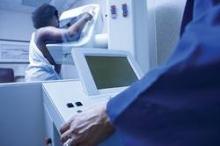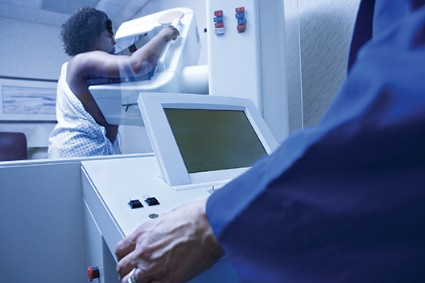User login
Higher payment rates for office visits – but not higher payment rates for the tests themselves – translate into more cancer screenings for Medicaid patients, a study showed.
Increasing cancer screening among Medicaid patients is a priority, as previous studies have found these patients less likely to be screened for breast, cervical, or colon cancer than people with private insurance. Medicaid patients are also more likely to present with advanced-stage cancers.
Dr. Michael T. Halpern of RTI International in Washington, D.C., and his colleagues, analyzed Medicaid claims data from 46 states and the District of Columbia to identify enrollees eligible for cervical screening, mammography, colonoscopy, and fecal occult blood testing in the year 2007. They looked at state-specific reimbursements for each test, which vary, along with state-specific income and eligibility requirements for Medicaid enrollment and office visit payment rates. Their findings were published Aug. 25 in Cancer (doi:10.1002/cncr.28704).
The researchers found that increases in test reimbursement rates did not consistently increase patients’ likelihood of receiving specific screening tests. Nor did the study find consistent associations concerning states’ Medicaid policies and screening. Stricter income, eligibility, and copayment requirements were associated with lower rates of screening for some tests and higher rates for others.
Higher office visit payment, though, was found to be significantly and consistently associated with an increased odds of receiving all recommended screening tests: colonoscopy (odds ratio, 1.07), a fecal occult blood test (1.09), a Pap test (1.02), and mammography (1.02).
Physician office visits were paid at rates of between $20 and $80, depending on state policy, the researchers found. A 20% increase in office visit payment was associated with increases in the odds of screening, ranging from 2.2% for mammography to 8.7% for a fecal occult blood test.
"The results of the current study are consistent with previous studies indicating that higher Medicaid reimbursements for office visits are associated with increased receipt of health care services, including preventive services," Dr. Halpern said. "As states expand Medicaid eligibility, it will be important to track state-specific changes in Medicaid enrollment, reimbursement rates, and eligibility requirements, and their impact on cancer screening, diagnosis at an early stage, and survival among individuals diagnosed with cancer."
Dr. Halpern and his colleagues said that their study was limited in that not all patients were enrolled in Medicaid for the full calendar year, the study did not capture patients in managed care plans, and investigators could not differentiate, using the data provided, between preventive cancer screenings and diagnostic procedures after symptoms or abnormal results. The study was funded by the Centers for Disease Control and Prevention, and none of its authors disclosed conflicts of interest.
Higher payment rates for office visits – but not higher payment rates for the tests themselves – translate into more cancer screenings for Medicaid patients, a study showed.
Increasing cancer screening among Medicaid patients is a priority, as previous studies have found these patients less likely to be screened for breast, cervical, or colon cancer than people with private insurance. Medicaid patients are also more likely to present with advanced-stage cancers.
Dr. Michael T. Halpern of RTI International in Washington, D.C., and his colleagues, analyzed Medicaid claims data from 46 states and the District of Columbia to identify enrollees eligible for cervical screening, mammography, colonoscopy, and fecal occult blood testing in the year 2007. They looked at state-specific reimbursements for each test, which vary, along with state-specific income and eligibility requirements for Medicaid enrollment and office visit payment rates. Their findings were published Aug. 25 in Cancer (doi:10.1002/cncr.28704).
The researchers found that increases in test reimbursement rates did not consistently increase patients’ likelihood of receiving specific screening tests. Nor did the study find consistent associations concerning states’ Medicaid policies and screening. Stricter income, eligibility, and copayment requirements were associated with lower rates of screening for some tests and higher rates for others.
Higher office visit payment, though, was found to be significantly and consistently associated with an increased odds of receiving all recommended screening tests: colonoscopy (odds ratio, 1.07), a fecal occult blood test (1.09), a Pap test (1.02), and mammography (1.02).
Physician office visits were paid at rates of between $20 and $80, depending on state policy, the researchers found. A 20% increase in office visit payment was associated with increases in the odds of screening, ranging from 2.2% for mammography to 8.7% for a fecal occult blood test.
"The results of the current study are consistent with previous studies indicating that higher Medicaid reimbursements for office visits are associated with increased receipt of health care services, including preventive services," Dr. Halpern said. "As states expand Medicaid eligibility, it will be important to track state-specific changes in Medicaid enrollment, reimbursement rates, and eligibility requirements, and their impact on cancer screening, diagnosis at an early stage, and survival among individuals diagnosed with cancer."
Dr. Halpern and his colleagues said that their study was limited in that not all patients were enrolled in Medicaid for the full calendar year, the study did not capture patients in managed care plans, and investigators could not differentiate, using the data provided, between preventive cancer screenings and diagnostic procedures after symptoms or abnormal results. The study was funded by the Centers for Disease Control and Prevention, and none of its authors disclosed conflicts of interest.
Higher payment rates for office visits – but not higher payment rates for the tests themselves – translate into more cancer screenings for Medicaid patients, a study showed.
Increasing cancer screening among Medicaid patients is a priority, as previous studies have found these patients less likely to be screened for breast, cervical, or colon cancer than people with private insurance. Medicaid patients are also more likely to present with advanced-stage cancers.
Dr. Michael T. Halpern of RTI International in Washington, D.C., and his colleagues, analyzed Medicaid claims data from 46 states and the District of Columbia to identify enrollees eligible for cervical screening, mammography, colonoscopy, and fecal occult blood testing in the year 2007. They looked at state-specific reimbursements for each test, which vary, along with state-specific income and eligibility requirements for Medicaid enrollment and office visit payment rates. Their findings were published Aug. 25 in Cancer (doi:10.1002/cncr.28704).
The researchers found that increases in test reimbursement rates did not consistently increase patients’ likelihood of receiving specific screening tests. Nor did the study find consistent associations concerning states’ Medicaid policies and screening. Stricter income, eligibility, and copayment requirements were associated with lower rates of screening for some tests and higher rates for others.
Higher office visit payment, though, was found to be significantly and consistently associated with an increased odds of receiving all recommended screening tests: colonoscopy (odds ratio, 1.07), a fecal occult blood test (1.09), a Pap test (1.02), and mammography (1.02).
Physician office visits were paid at rates of between $20 and $80, depending on state policy, the researchers found. A 20% increase in office visit payment was associated with increases in the odds of screening, ranging from 2.2% for mammography to 8.7% for a fecal occult blood test.
"The results of the current study are consistent with previous studies indicating that higher Medicaid reimbursements for office visits are associated with increased receipt of health care services, including preventive services," Dr. Halpern said. "As states expand Medicaid eligibility, it will be important to track state-specific changes in Medicaid enrollment, reimbursement rates, and eligibility requirements, and their impact on cancer screening, diagnosis at an early stage, and survival among individuals diagnosed with cancer."
Dr. Halpern and his colleagues said that their study was limited in that not all patients were enrolled in Medicaid for the full calendar year, the study did not capture patients in managed care plans, and investigators could not differentiate, using the data provided, between preventive cancer screenings and diagnostic procedures after symptoms or abnormal results. The study was funded by the Centers for Disease Control and Prevention, and none of its authors disclosed conflicts of interest.
FROM CANCER
Key clinical point: Higher payment rates for Medicaid office visits could lead to more cancer screenings in an at-risk population.
Major finding: Higher office visit payment was significantly and consistently associated with an increased odds of receiving colonoscopy (odds ratio, 1.07), a fecal occult blood test (1.09), a Pap test (1.02), and mammography (1.02).
Data source: Medicaid claims data in 46 states and the District of Columbia
Disclosures: The study was funded by the Centers for Disease Control and Prevention; the authors disclosed no relevant conflicts of interest.

